March itinerary in Japan Day 1 (Hiroshima Meal edition)
(Tuesday, March 22)
Table of contents
1. Denko Sekka Ekimae Hiroba store
1. Denko Sekka Ekimae Hiroba store
After arriving in Hiroshima city, I went to the “Denko Sekka Ekimae Hiroba store” near Hiroshima station and ate Hiroshima-style okonomiyaki.
“Denko Sekka Ekimae Hiroba store” is a popular restaurant that has been selected as one of the 100 Tabelog restaurants. Unlike regular Hiroshima-style okonomiyaki, the specialty is “Denko Sekka,” which wraps the okonomiyaki dough with fluffy eggs. I ordered “Denko Sekka” (Yen 1,100). It’s delicious, but in conclusion, I prefer the traditional Hiroshima-style okonomiyaki. However, I think it is just right for those who are tired of traditional Hiroshima-style okonomiyaki. I think that Hiroshima citizens who eat Hiroshima-style okonomiyaki every week need such a slightly unusual new version.
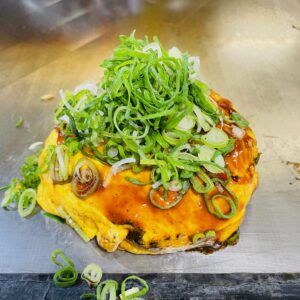
Hiroshima-style okonomiyaki is a “Local dishes loved by the nation” of Hiroshima prefecture selected by the Ministry of Agriculture, Forestry and Fisheries. The biggest feature of Hiroshima-style okonomiyaki is “Kasane-Yaki (layered grill),” which is baked without mixing the dough and ingredients. It is said that Isao Ise of “Micchan” and Zenjiro Nakamura of “Zen-san”, who opened at a food stall around 1950, are the originators of Hiroshima-style okonomiyaki. Initially, it was a layered grill of vegetables without noodles or meat, folded in half and wrapped in newspaper.
Hiroshima citizens dislike the name “Hiroshima-style okonomiyaki” and simply call it “okonomiyaki”. However, I had the impression that many of the stores on this trip to Hiroshima had “Hiroshima-style okonomiyaki” written on the signboard. Generally speaking, if you don’t say “Hiroshima-style okonomiyaki”, it is likely to be confused with “okonomiyaki” in Osaka. This would be the same as people other than Akashi calling “Akashi-yaki” instead of “Tamago-yaki”, which is a specialty of Akashi City, Hyogo Prefecture.
According to the website “Prefectural Citizenship by Prefecture Statistics and Ranking”, Hiroshima Prefecture ranked first with 41.48 okonomiyaki restaurants by prefecture per 100,000 population. The number of okonomiyaki restaurants in Hiroshima prefecture is overwhelming, with 17.65 in Tokushima prefecture in 2nd place, 16.92 in Ehime and Hyogo prefectures in 3rd place, and 15.40 in Okayama prefecture in fifth place. Certainly, even if you walk in Hiroshima city, there are many okonomiyaki restaurants. It is very surprising that Osaka prefecture is not in the top five. Looking at the overwhelming number of okonomiyaki stores, it is easy to understand that the people of Hiroshima do not call it “Hiroshima-style okonomiyaki” but simply call it “okonomiyaki”.
The roots of okonomiyaki are said to be “dondon-yaki” in Tokyo, “nikuten” in Kobe, and “issen-yoshoku” in the Kinki region. Both are dishes that existed before the Taisho era (1912-1926). It is very strange that Osaka, which loses the consumption of okonomiyaki and is not the root of okonomiyaki, is regarded as the center of “okonomiyaki”. The Osaka specialty “Takoyaki” is said to have its roots in “Akashi-yaki”.
2. Beer stand Shigetomi
After sightseeing in Hiroshima city, I drank blissful draft beer at “Beer Stand Shigetomi” from 17:00. I arrived at the store at 16:50, 10 minutes before the store opened. No one was lined up when I arrived, but there was a line by the opening time.
Mr. Hiroshi Shigetomi, the owner of “Beer Stand Shigetomi”, is a master of beer pouring, which is said to be a beer evangelist. At “Beer Stand Shigetomi”, Mr. Shigetomi wants to go not only to his own restaurant but also to other restaurants. Therefore, Mr. Shigetomi has decided that the business hours are only 2 hours from 17:00 to 19:00, the order is up to 2 glasses of beer, and the staying time is up to 20 minutes. At first, I thought that the store that decides these rules would be uncomfortable, but Mr. Shigetomi was a soft person and I didn’t have to worry about it in advance.
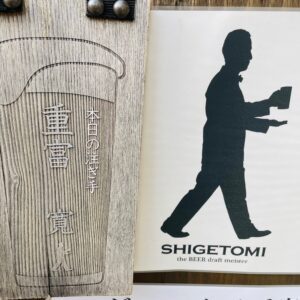
At “Beer Stand Shigetomi”, there are only standing seats with wooden barrels as tables. The beer server seems to be a modified version of an old refrigerator. When I asked Mr. Shigetomi, he said that he bought it at the auction.
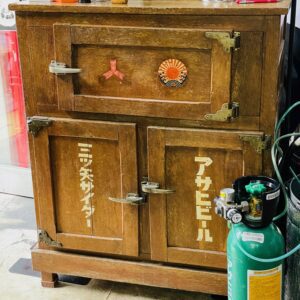
I ordered “Once pouring” for the first glass and “Sharp pouring” for the second glass. “Once pouring” is a beer that “exhilarates like running through your throat! Recommended for today’s first drink”. It’s a refreshing beer, so it’s perfect for your first beer. However I thought it was difficult to feel the skill of a beer pouring master by “Once pouring”.
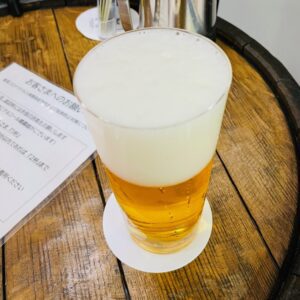
“Sharp pouring” is “a crisp and sharp taste with carbonic acid and bitterness. A miracle glass poured from two servers, Showa and Heisei.” I was impressed with the deliciousness of “Sharp pouring”, the beer foam itself was mild and delicious, and the beer had a refreshing taste and was the best mix taste.
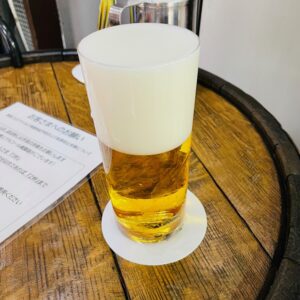
If you want to taste the skill of a master of beer pouring, “Sharp pouring” and “Mild pouring” are good. Even in the explanation of “Beer Stand Shigetomi”, only “Sharp pouring” and “Mild pouring” were written as “Beer Stand Shigetomi” original. In addition, the explanation of “Mild pouring” said, “A gentle taste that firmly suppresses carbonic acid and bitterness. Recommended for those who are not good at beer.” I like beer, so I ordered “Sharp pouring” and it was the correct answer.
In addition, there were “Twice pouring” and “Three times pouring”. The explanation of “Twice pouring” was “Add the taste of beer to the refreshing feeling of once pouring. The best balance that you will not get tired of drinking.” In addition, there was an explanation in “Three times pouring” that “By removing carbonic acid moderately, you can feel the sweetness of malt. It has a soft taste. Bubbles that rise from the glass.”
In the explanation of “Beer Stand Shigetomi”, the famous beer stores of “Once pouring” are “Ginza Lion, New Tokyo, Sapporo Beer Garden”, and the famous beer stores of “Twice pouring” are “Bier Reise 98, Nada Colombia, New Munich”, the famous beer stores of “Three times pouring” are “Kirin City, Keller yamato”.
It was the first time for me to introduce another beer store. I really sympathize with the management attitude of thinking about the beer industry and the restaurant as a whole. Mr. Shigetomi is doing a project to “make a smile with delicious beer and energize the city of Hiroshima”. I thought it was a great concept store. The next time I visit Hiroshima, I definitely want to visit it again.
3. Takenoshita
After enjoying a delicious beer at “Beer Stand Shigetomi”, I had dinner at “Takenoshita”. Everything I ordered was delicious, the service of the restaurant waitress was very good, the interior was nice and it was a very satisfying dinner.

On this day, I ordered “sashimi platter”, “sashimi of conger eel”, “pickled wasabi leaves”, “salad of Wagyu beef KOUNE meat (brisket) and small turnips”, and “deep-fried oysters in dashi broth”.
The “sashimi platter” included hairtail, flounder, octopus, Spanish mackerel, and Spindle snail. Everything was delicious, but especially the hairtail sashimi was excellent. It may have been the best hairtail sashimi of my life. Spindle snail are mainly caught in Hiroshima prefecture, and now the catch is decreasing and it seems that they are becoming high-class shellfish. I ate Spindle snail for the first time. It was sweet and delicious.
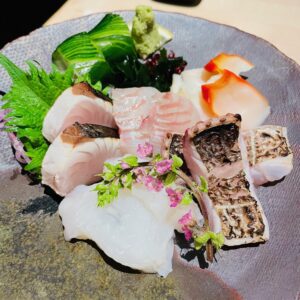
“Conger eel sashimi” was thin and beautifully presented like “Tessa (blowfish sashimi)” at first glance. The taste was excellent. In addition, the parboiled conger eel skin was a delicacy with a crunchy texture. It was great taste to wrap the parboiled conger eel skin by conger eel sashimi. It was a very memorable dish.
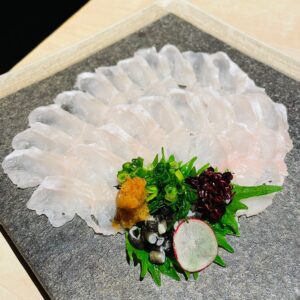
“Pickled wasabi leaves” had a savory spiciness and was a good side dish served between the main courses.
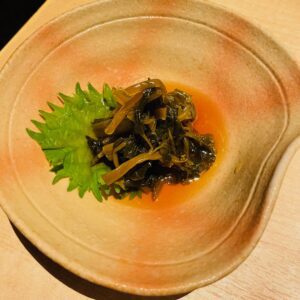
I ordered “Wagyu beef KOUNE meat and small turnip salad” because I was interested in “KOUNE meat”. “KOUNE meat” is a part of beef shoulder ribs, which is the meat around the side of the front legs. Also known as “Brisket”. “KOUNE meat” was found in many restaurants. “KOUNE meat” seems to be eaten quite often among the people of Hiroshima, but I haven’t seen it much outside of Hiroshima. This is a typical local dish. “KOUNE meat” was a very delicious beef that the more you chew it, the more delicious gravy oozes out.
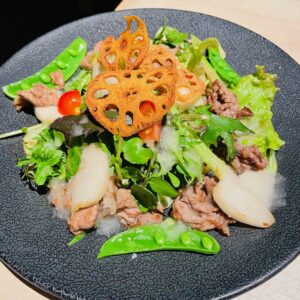
I ordered “Agedashi oysters (deep-fried oysters in dashi broth)” because I thought it would be the final stage of the season. Usually, oysters are eaten raw, grilled or fried, but deep-fried oysters are a rare way to eat them. “Agedashi oysters” was very delicious.
“Hiroshima oysters” have been selected as the winter “PRIDE FISH” (season: January-March) in Hiroshima Prefecture by Japan Fisheries Co-operative. Hiroshima Prefecture has the highest production of oysters in Japan. Its production share is overwhelming at 60.4% (2020). Miyagi Prefecture is second in production, Okayama Prefecture is third, Hyogo Prefecture is fourth, and Iwate Prefecture is fifth.
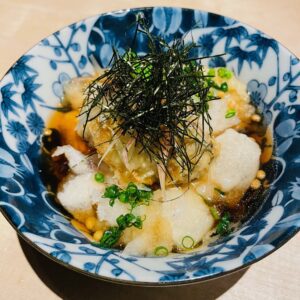
4. Henkutsuya Main Store
After having a very satisfying dinner at “Takenoshita”, I had Hiroshima-style okonomiyaki at “Henkutsuya Main Store“.
“Henkutsuya” is a historic restaurant that was founded in 1947, shortly after World War II. They started as the okonomiyaki stand. I ordered “Soba with meat” (Yen 850). The Hiroshima-style okonomiyaki of “Henkutsuya” was delicious with the old-fashioned taste. However, I wondered if the taste was a little lacking in punch.
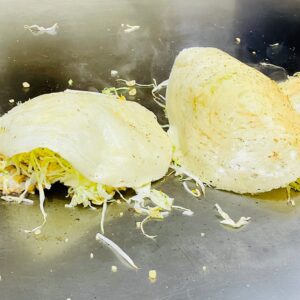
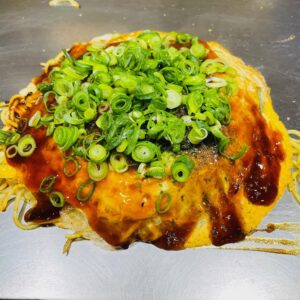
I also had Mino-yaki (Grilled Rumen) at “Henkutsuya”. In addition to okonomiyaki, there are also snacks (oysters, beef, pork, chicken, etc.) that are grilled on an iron plate at the okonomiyaki restaurant in Hiroshima. It seems that Hiroshima-style is to drink alcohol with these grilled snacks, and finally eat okonomiyaki. On the day I visited “Henkutsuya”, many locals drank alcohol with snacks and ordered okonomiyaki at the end.
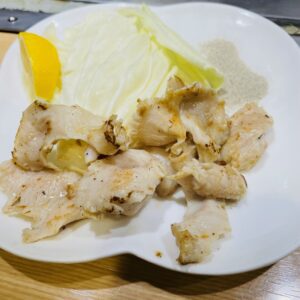
Note: The departure / arrival times, fares of transportation, admission fees, meal fees, etc. listed in the text are as of the time of writing the BLOG. Please check for yourself when you go on a trip as it may change in the future.